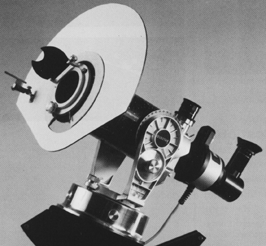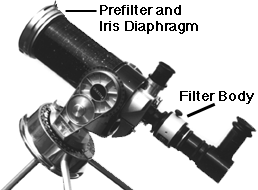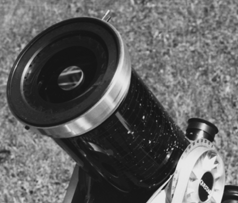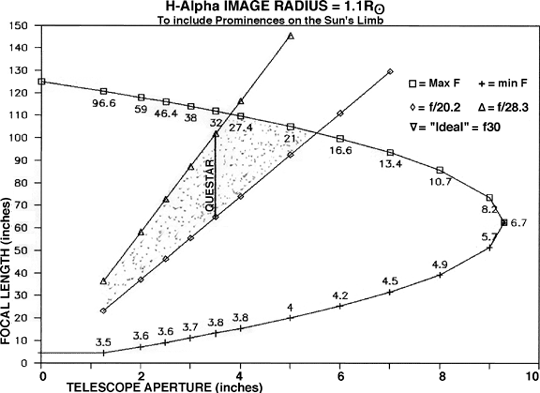Questar Distribution
![]() News
News ![]() Notes & Interesting Articles
Notes & Interesting Articles ![]() Overview
Overview ![]() Pricing
Pricing ![]() Products
Products ![]() Service or Repair
Service or Repair
Questar Telescopes ![]() LD Surveillance Systems
LD Surveillance Systems ![]() LD Microscopes
LD Microscopes ![]() Accessories
Accessories

 |
The Questar Solar Observatory system was developed by a local customer of Company Seven with the cooperation of DayStar Filter Company and of Company Seven. The following is the article prepared by Mr. Olshausen for publication in the Company Seven "C-VII Journal" in 1990. |
"A TELESCOPE FOR LOVERS OF THE SUN"
Copyright 1990, by Michael OlshausenUsed by permission
The life-giving Sun: it's big, it's bright, it's magnificent. Jupiter-size sunspot groups, formed when the convective upwelling of hot gasses to the photosphere temporarily becomes retarded by emerging solar magnetic flux tubes, are conspicuous around Solar Maximum. Flares erupt, visible in H-alpha, the red light of hydrogen, near these same sunspot groups -- termed "active regions" -- occasionally showering the earth's magnetosphere with astronaut-lethal X-rays and energetic protons. Magnetic flux tubes loop up into the chromosphere and support enormous quiescent prominences, sometimes 100,000 miles high and again easily visible in H-alpha. These same flux tubes provide the confined magnetic conduits for the explosive, surge prominences that erupt from the active regions.
To share these extraordinary phenomena with friends and students, the author assembled a personal solar telescope satisfying four criteria: 1) high portability, 2) high precision, 3) full utilization of available aperture to preserve telescopic resolving power, and 4) an angular field of view sufficiently wide as to allow the whole solar disk plus prominences to be viewed at once, at the lowest power. Constraining the telescope's design, but only in H-alpha, was the optical requirement imposed by all narrow-band, Lyot, or (as here) etalon, interference filters, of a nearly plane-parallel wave front: requiring, in practice, an f/30, or slower, optical system. Also constraining the telescope's design was the aperture stop of the interference filter, and the field stop of the lowest power (32mm) eyepiece.
Questar telescopes easily satisfy criteria 1 and 2, particularly with their new, battery-powered drives. Among the commercially available H-alpha filters, DayStar's T-Scanner (Tilt Scanner) eliminates the need for an oven (interference filters are temperature sensitive, varying +1.0 Angstrom over +16.80C), and so, in practice, eliminates the need for an AC line. The T-Scanner achieves this shortcut by providing a thumbscrew-controlled mechanism for tilting the filter, thereby compensating for ambient thermal displacements of the central wavelength of the filter's passband (called the "fringe"). You can actually see the fringe scan across the solar image, as if passing a wand over a magic hat. Observation of H-alpha detail, principally of filaments, plages, flares, and sunspot magnetic field alignments, over isolated regions of the solar disk is very pleasing and easily accomplished, despite the approximately square-wave contrast distribution. True uniformity of contrast over the disk is possible with a T-Scanner only when the filter element is squared-on to the incoming, convergent light beam from the telescope objective. At only one temperature can this occur. On the other hand, because DayStar's T-Scanners have sub-angstrom half-bandwidths, the contrast over isolated solar regions is excellent, regardless of temperature (especially if the telescope's effective focal ratio is increased by stopping the objective). At additional cost, DayStar may be able to provide extra-narrow, sub-angstrom T-Scanners, for enhanced disk contrast. For observers who want to photograph the sun in H-alpha, an oven- regulated DayStar interference filter would definitely prove superior to the economical T-Scanner.

Questar with diaphragm/prefilter, DayStar filter body, diagonal on axial port in place
With this in mind, the author asked DayStar to produce a full-aperture prefilter for his 3.5" Questar. The first full-aperture prefilter specifically built for Questars, this prefilter has been equipped (by the author) with a full-aperture iris diaphragm from Edmund Scientific Co. With the T-Scanner linked to the Questar through the Questar swivel for easy viewing, and with all three Questar camera extension tubes placed between the T-Scanner and Questar's formerly available (and perhaps newly available) Televid star diagonal (see photo), and further with the iris stopped down to 2.5", the system f-ratio is f/28.3. Disk detail stands out in remarkably good contrast. Contrast can be enhanced notably by stopping down to 1.25" off-axis (or to f/56.6 with the extension tubes in place!) with, however, a consequent loss of resolution and light. It should be noted that, to enable Questar's screw-on, camera extension tubes to be inserted between the T-Scanner and the Televid star diagonal, a custom-threaded male-male coupling first needed to be lathed.

View of Questar front cell with diaphragm in place
With the iris fully open to 3.5", the system f-ratio is f/20.2. Although considerable loss of contrast over the disk results from this lowered f-ratio, the light gains and resolution gains in the prominences, especially at powers above 100, more than justify the added expense of the full-aperture prefilter.
The author's 3.5" Questar prefilter is as large as the off-axis, sub-diameter prefilters offered for 11" Celestrons. On the other hand, because the conventional T-Scanner has a 1.25" aperture stop, no 10"-or-larger telescope equipped with a T-Scanner can both display the whole solar disk without vignetting the telescope's objective and also work at an f-ratio suitable for good contrast in H-alpha (see the graph and derivation, below). Stopping-down becomes necessary. Of course, custom T-Scanner's with larger aperture stops could easily overcome this purely geometrical problem, although, presumably, at much greater expense.

Note: focal length alone determines whether the "Disk + l0X" image can pass through the filter's aperture stop. A focal length of 10 feet, regardless of aperture size, i.e. regardless of losses of resolution from vignetting, always results in a solar disk 1.13" across (seasonally averaged).
With dimensions expressed in inches, we have:
e = tan-1 [D - 1.10 (1.13/120) F] / 2F (Note: 10 ft. = 120 in.)

It should be noted that the above geometrical results apply only to an idealized, simplest case. When internal light baffles vignette the objective at the solar limb, the aperture is effectively stopped-down already. This is probably the case with Questars. High-power, center-field views, however, remain unvignetted.
Experiments with a T-Scanner in combination with the full-aperture prefilter confirmed that no conventional combination of Questar Barlows, used to boost the effective f-ratio, yields satisfactory results. Using the standard, swing-into-position Questar Barlow, the observer will find that, in the central third of solar disk, H-alpha details are entirely washed out, according to DayStar. Only by stopping down to 1.25" off-axis may Questar's internal star diagonal be used successfully with an H-alpha filter. But this use defeats the purpose -- of maintaining full resolution and full light-gathering power, especially for observation of the relatively faint solar prominences -- of the full-aperture prefilter.
Axial Questar Barlows, of which the author experimented with both the 1.5x and 2x variety, when situated close to the interference filter produce an annoying, observationally useless, annular fringe. When these axial Barlows are separated from the interference filter by means of the Questar swivel, the solar image produced is too large to pass through the field stop of the lowest-power, 32mm, eyepiece. Noticeable degradation of image quality also results.
According to DayStar, a Barlow lens can, in fact, be successfully used with refractors, provided the Barlow is inserted rather far up into the optical tube; DayStar (and Company Seven) may be able to provide such Barlows.
An important gain in contrast results from using a polarizing filter at the telescope eyepiece. This is because the light emerging from an H-alpha interference filter is, in practice, elliptically, rather than circularly, polarized. Since filaments on the solar disk (prominences seen in projection) are only observed because they scatter light, reduction of background glare by analyzing away the linear polarization component enhances their visibility.
The author recommends applying a small, first-surface, circular mirror (available from Edmund) to the center of the prefilter to eliminate differential heating of the Questar secondary. He also recommends fully stopping down the telescope at regular intervals in order to dissipate accumulated heat from the T-Scanner, and so to maintain the filter's central wavelength close to H-alpha. Over time, this treatment will also retard the aging of the T-Scanner's internal blocking filters, and so will extend the filter's pre-overhaul lifetime.
One of the lovely features, incidentally, of DayStar's T-Scanner is its ability to scan on either side of H-alpha, at 6562.8 Angstroms, and thus to allow observation of Doppler shifted detail in filaments and prominences. For amateur astronomers, there is probably no better, nor more dramatic, way of demonstrating the Doppler shift of light, a sure give-away that the emitting prominence material has a positive or negative radial velocity.
Happy solar observing!
Contents Copyright 1994-2000 Company Seven - All Rights Reserved

